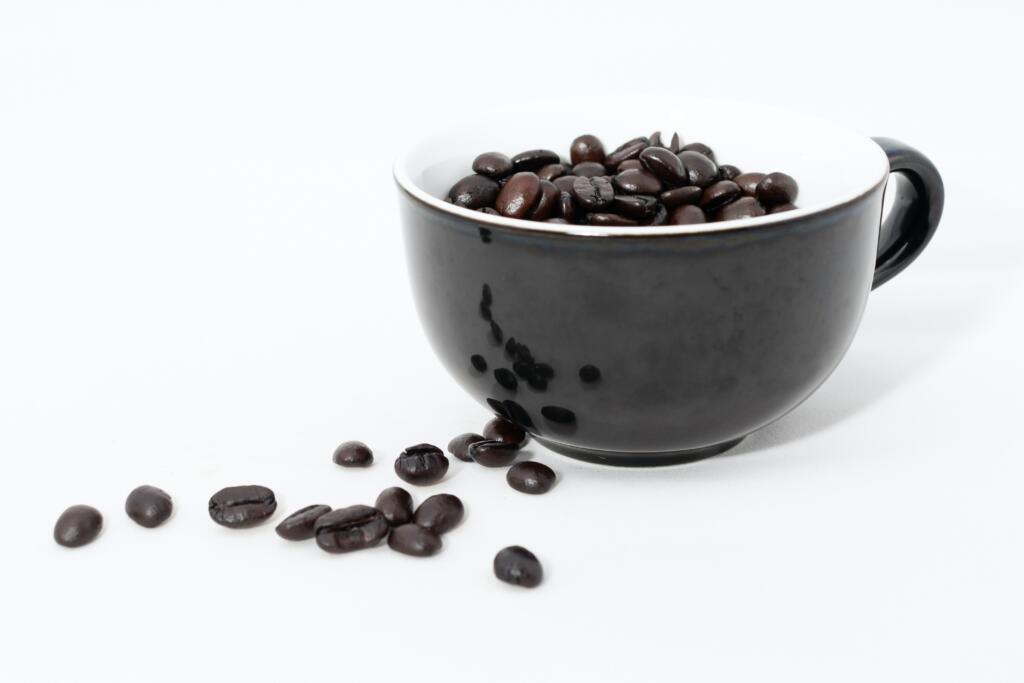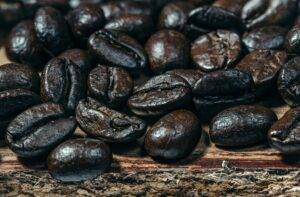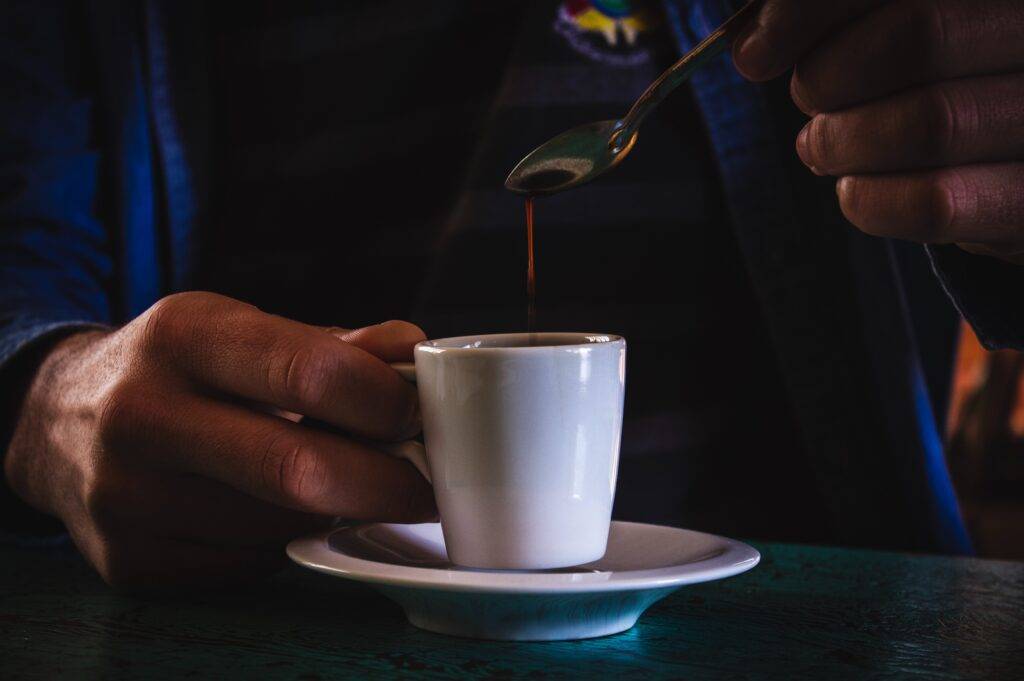If you’re a coffee lover, you know there are all kinds of roasts. One of the most popular is a dark roast. But what exactly is it?
Table Of Contents
−- What is dark roast coffee?
- History of dark roast coffee
- Benefits of dark roast coffee
- Types of dark roast coffee
- What does dark roast coffee taste like?
- The roasting process for dark roast coffee
- The type of coffee beans plays an important role
- Flavor
- Strength
- Caffeine content
- Best way to brew
- What is the acid content of a dark roast?
- Does dark roast need to be shiny?
- Food pairing with dark roast coffee
- Iced or hot?
- Light vs. Dark Roast
- Medium vs. Dark Roast
- Conclusion
In this blog post, we’ll explore the characteristics and flavor of dark roast coffee and help you find the best beans for your cup.

What is dark roast coffee?

Dark roast coffee is a type of coffee that has been roasted for longer than light or medium roast coffee. It has a dark brown color with an oily surface characterized by its low acidity, heavy body, and intense flavor notes.
The beans are roasted at a higher temperature, which causes more moisture to be released from them and gives them their unique flavor. Dark roast coffees are well-rounded and have a richer, more robust taste than lighter roasts.
Whether you prefer your coffee black or with cream and sugar, you can find something to enjoy in dark roast coffees.
History of dark roast coffee
The history of dark roast coffee goes back centuries, with the first recorded implements for roasting coffee beans being thin pans made from metal or porcelain, used in the 15th century in the Ottoman Empire and Greater Middle East.
It was believed that the darkness of the roast and its uniform look would make the beans more “desirable” to consumers. This is the origin of super dark roast (aka French or Italian roast) and why coffee got that “bitter, burnt, ashy” reputation.
Starbucks remains devoted to this style of dark roast made popular in the ’60s, which has led to a swell in America’s third-wave coffee culture. With its oils released onto the bean during the roasting process, dark roast coffee provides a low acidity, heavy body, and strong flavors that have become a hallmark of specialty coffee.
Benefits of dark roast coffee
Dark roast coffee has various health benefits, making it a great choice for coffee lovers. Studies have found that dark roast coffee contains more antioxidants like polyphenol and chlorogenic acid than light roasts, which may help protect the body from free radicals and reduce inflammation.
Additionally, dark roast coffee may boost antioxidants like glutathione, referred to as the “master antioxidant,” and restore red blood cells. This can help reduce cancer risk, improve brain health, and increase liver power. With these advantages, it is no wonder why dark roast coffee has been around for centuries and continues to be a popular choice for coffee drinkers worldwide.
Types of dark roast coffee
Types of Dark Roast Coffee come in wide different varieties.
French Roast
French roast coffee is one of the most popular types of dark roast coffee. It is characterized by an intense and smoky-sweet taste, with a full body and a lower caffeine content than other roasts.
This dark roast is achieved by roasting the beans longer than other roasts, giving it its unique flavor and aroma. French roast coffee is also great for pairing with food, as it adds a deep richness to any dish.
Italian Roast
Italian roast is a popular dark roast coffee originating in southern Italy. It is set apart by its burnt flavor and high heat applied during the roasting process, leading to exceptionally oily and dark beans. It is one of the darkest roasts – generally around 245°C (473°F).
It has a strong and bitter taste, a full body, and slightly smoky undertones. Italian roast pairs well with robust flavors such as dark chocolate, nuts, and dried fruit. It is also great for making espresso-based drinks. Italian roast is great for those looking for a smooth yet robust cup of coffee!
Espresso Roast
Espresso roast is darker than French roast and is generally roasted until the beans reach a temperature of 495°F. This type of roast has a fuller body and flavor profile than light or medium roasts, and the espresso beans have a strong, smoky flavor and aroma.
This dark roast has a thick crema on top and is often used in espresso-based drinks like lattes, cappuccinos, macchiatos, and more. When brewed correctly, espresso roast can create an intensely flavorful cup with a full body that stands up to milk-based drinks.
Vienna Roast
Vienna Roast is one of the many types of dark roast coffees and has unique characteristics. This roast type is characterized by a slightly deeper color than American Roast, with small oil spots on the bean’s surface. A distinctive flavor is created during the roasting process, which results in a medium-dark roast that toasts the beans to perfection.
This roast type is brewed using 100% Arabica beans and has a medium to full body with a sweet flavor. Vienna Roast is an excellent option for those looking to enjoy a rich cup of coffee without the smokiness of a French Roast. It pairs well with food and can be brewed using various methods to create a flavorful cup of coffee.
What does dark roast coffee taste like?
Decades and decades ago, roasting meant heating coffee beans over a flame until the oils became visible to the bean’s surface. To avoid fire hazards, roasting is ceased just before smoke results from the oils.
To make the story short, coffee was dark, burnt, bitter, and ashy. But don’t fret! Your dark roast coffee today does not need to be all that.
Dark roast beans have the least unusual flavors but the best. They’re not soft or even—far from it—but most dark roasts share rich flavors of:
- Dark chocolate
- Spice
- Woodiness
More on that later; they are the least acidic, they have the heaviest body, and they have a bold, rich aroma.
The roasting process for dark roast coffee
The roasting process for dark roast coffee is more extensive than lighter roasts, with beans being roasted for a longer time. This results in the beans being darker and having a stronger taste with less acidity.
The dark roasting process begins with temperatures reaching 400 degrees Fahrenheit and the beans being roasted until they reach the desired color and taste.
During this process, the beans will reach a point where they crack, producing a sound similar to popcorn popping. The length of the roast will depend on the desired results and the type of coffee bean used.
For example, French Roast coffee beans are usually roasted for a longer amount of time than Italian Roast coffee beans. Once finished, the dark-roasted beans are cooled quickly to stop the roasting process and preserve their flavor.
The type of coffee beans plays an important role
There are two types of commercially grown coffee beans around the world, Arabica and Robusta. In the case of darker roasts, the manufacturers use them equally.
While Arabicas are considered higher quality, Robusta beans, with their dark and earthy tones, can find a place in a dark roast blend.
They add a depth of taste but deliver twice as much caffeine, which is an enticing feature for some coffee drinkers.
Flavor

When we think about the dark roast, “classic” is the word that comes to mind. Classic coffee houses a strong aroma with a smooth and chocolatey taste with just the perfect bitterness to balance.
Sweet
- Dark chocolate
- Fresh cola
- Maple syrup
- Creamy caramel
Spices
- Anise
- Nutmeg
- Cinnamon
Nuts
- Hazelnut
- Praline
- Peanut butter
The presence of oil can make the body of the coffee quite thick and heavy.
Strength
Dark roast is for you if you’re all for the heavy body and creamy chocolatey feel. These characteristics can trick you into thinking that it is strong. However, a strong taste doesn’t necessarily mean a strong coffee.
Take note that the strength of the coffee is influenced by the brew concentration rather than the taste.
Caffeine content
Dark roast coffee is known for its bold flavor and deep aroma, but it is often assumed to contain more caffeine than light roast.
However, according to factual data, the caffeine content in both dark and light roast coffee is virtually the same. Generally, one cup of regular Drip-Brewed Arabica coffee with a medium roast will have about 120 milligrams of caffeine.
Because light roast is roasted for less time, it is denser and heavier than dark roast. As a result, each particle of ground light roast contains more caffeine per gram than a darker roast; however, the amount of caffeine per bean is the same for both types.
So regardless of whether you prefer a dark or light roast, rest assured that your morning cup of joe will get you going with just the right amount of caffeine!
Best way to brew

When it comes to versatility, dark roast comes first. The consistency of flavors makes them survive through all the heat and pressure. This is also why a dark roast creates a great espresso.
Be it as a drip coffee, espresso, or pour-over; you will surely have a truly enjoyable drink. We roast a little lighter since we prefer coffee without the overpowering bitterness and burnt taste to allow that coffee’s natural flavor to be the show’s star.
The basic things to consider, as always, are:
Grind size
Make sure you’re working with the accurate grind size based on how you want to make your coffee, Moka pot, Espresso, etc.
Water temperature
190 to 195°F. For a dark roast, you may want to lower the temperature of the water to reduce the chance of bitterness.
Contact time
The longer the contact time, the more coffee extraction takes place. A pot usually takes 6 minutes to brew, while an espresso can take as quick as 25 seconds.
Freshness
The older the coffee, the more oxidation takes place. With oxidation, flavors change as well. Use coffee beans that are as fresh as possible to have your best cup.
What is the acid content of a dark roast?
The acid content of a dark roast can vary, but on average, it is slightly less acidic than a light roast. Studies have found that dark roast coffee contains higher levels of N-methylpyridium, calming stomach cells and decreasing the amount of acid produced.
Also, because dark roasts are roasted for a longer time, they contain fewer compounds that cause acid production. However, the pH of the brewed coffee is still the same as other roasts.
Espresso is an excellent choice for those looking for a low-acid option, with a pH of 5.31 (the same as rainwater). The resulting brew is full of smooth flavor and gentle on the stomach.
Does dark roast need to be shiny?
Well-developed dark roast beans have surface oils on them. These oils reach your taste buds when brewed and provide a lingering aroma. But this is not where the flavor comes from alone.
You might think twice if your coffee is shiny since it may be over-roasted. A good dark roast ideally has oils inside the beans. This way, the delicate flavors are preserved since contact with oxygen is prevented.
Food pairing with dark roast coffee

Due to its low perceived acid, this roast is the easiest to pair with.
And, of course, anything you have on your breakfast table works well too!
Pairing Food with Dark Roast Coffee
Pairing food with dark roast coffee can be a great way to enhance the flavor of the food and the coffee.
Dark roast coffees are typically more nutty and bitter, making them the perfect complement to denser, full-flavored foods such as dark chocolate cake and truffles.
The full body and robust flavor profiles of a dark roast are well complemented by dense and full foods such as dark chocolate cake and truffles, tiramisu, creamy desserts, pork, beef, and lamb, and chocolate mousse and wheat bread.
Salty foods like pork, beef and lamb also go well with dark roasts because the saltiness helps elevate the flavors in the coffee. It also goes well with spicy food like curries and cream-based soups.
Sweeter options like milk chocolate, dark chocolate, caramel, and hazelnut spread are also great for pairing with darker roasts. For dessert, try something chocolaty like chocolate cake or mousse or something fruity like a fruit tart or scone. You can also try some classic treats like doughnuts and croissants that pair perfectly with a dark roast. Yogurt and cheesecakes also offer some nice contrast.
Iced or hot?
Dark roast is so versatile that it’s equally great whether hot or iced.
The deep, nutty, and chocolate flavors create some rich cold brew, while a hot cup is also one of the most comforting beverages in the world.

Light vs. Dark Roast
Light roast houses floral and fruity notes with more acidity than dark roast. It also has no oil on the surface. Dark roast lovers may not find light roast enticing as it houses largely different experiences than the former. Read more about the difference between light vs. dark roast.
Is Dark Roast Coffee healthier than light roast?
A study showed that dark roast coffee is more effective in lowering body weight and restoring healthy volunteers’ red blood cell vitamin E and glutathione concentrations.
Medium vs. Dark Roast
If you enjoy your dark roast but wonder if it has more fruity notes, then you must try medium roast. With a less heavy body and more flavors, you can enjoy the smooth and toasty feel of a dark roast with a twist. Read more about the differences between these two beans.
Conclusion
In conclusion, dark roast coffee is a great option for those looking for a bold and full-bodied cup of joe.
Not only does it have a rich and robust flavor, but it also has less caffeine than light roast coffee. It has a more complex aroma and flavor than light roasts, and its roasting process results in less acidic and more mellow beans.
Brewing tips can help bring out the best in dark roast coffee and pair well with different types of food. So those who want a bolder cup of coffee should look into dark roast varieties!
Ready to try some of the best dark roast coffee?
Disclaimer: This post contains affiliate links, which means I may receive a small commission, at no extra cost to you, if you make a purchase using these links. Remember to support us by purchasing through the Amazon/Walmart/Impact Radius links provided. Last update on 2024-04-26 / Affiliate links / Images from Amazon Product Advertising API
Disclosure: No compensation or free products were received in exchange for writing this review.

Editorial Staff
The editorial staff at Crazy Coffee Crave is a team of coffee enthusiasts & Baristas who enjoy the one thing we all think about as soon as we get up in the morning. Trusted by thousands of readers worldwide.





